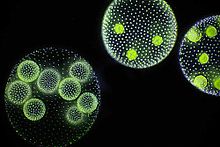Volvox
| Volvox | |
|---|---|
 |
|
| Volvox sp. | |
| Scientific classification | |
| Kingdom: | Viridiplantae |
| Division: | Chlorophyta |
| Class: | Chlorophyceae |
| Order: | Volvocales |
| Family: | Volvocaceae |
| Genus: |
Volvox L. |
| Species | |
|
Volvox aureus |
|
Volvox aureus
Volvox carteri (V. nagariensis)
Volvox globator
Volvox barberi
Volvox rouseletti
Volvox dissipatrix
Volvox tertius
Volvox is a polyphyletic genus of chlorophyte green algae in the family Volvocaceae. It forms spherical colonies of up to 50,000 cells. They live in a variety of freshwater habitats, and were first reported by Antonie van Leeuwenhoek in 1700. Volvox diverged from unicellular ancestors approximately 200 million years ago.
Volvox is a polyphyletic genus in the volvocine green algae clade. Each mature Volvox colony is composed of up to thousands of cells from two differentiated cell types: numerous flagellate somatic cells and a smaller number of germ cells lacking in soma that are embedded in the surface of a hollow sphere or coenobium containing an extracellular matrix made of glycoproteins. Adult somatic cells comprise a single layer with the flagella facing outward. The cells swim in a coordinated fashion, with distinct anterior and posterior poles. The cells have anterior eyespots that enable the colony to swim towards light. The cells of colonies in the more basal Euvolvox clade are interconnected by thin strands of cytoplasm, called protoplasmates. Cell number is specified during development and is dependent on the number of rounds of division.
...
Wikipedia
